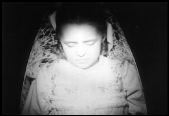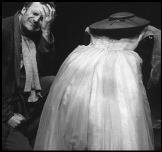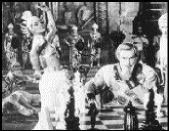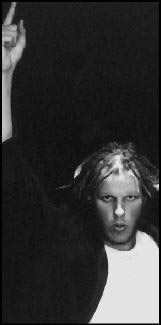WISCONSIN DEATH TRIP
directed by James Marsh runs Oct. 26-Nov. 1 at Grand Illusion
A PAIR OF young lovers joyously stripping to corset and union suit while splashing merrily into the river seems so out of place in James Marsh’s brutal 1999 documentary that you brace yourself to see one bludgeon and drown the other. Wisconsin Death Trip‘s steady litany of violence, psychosis, and suicide prepares us to expect the worst. After such wallowing in the macabre, the incongruous announcement of a happy marriage between the two romantic runaways makes us reel.
Gripped by economic depression, harsh winters, and a devastating diphtheria epidemic, the people of rural 1890s Black River Falls, Wis. appear to have fallen prey to collective madness. Ian Holm dispassionately narrates a grim catalog of abandoned children, arson, jilted lovers’ revenge, self-immolation, and insanity taken from the town newspaper and records of the nearby Mendota Insane Asylum. A debt-ridden farmer dynamites his head, announcing, “Here I go, and the Lord go with me.” A girl repeatedly sets fire to her house out of sheer boredom. A mother, hearing voices, drowns her three children. A 14-year-old runaway boy remorselessly murders a farmer for the thrill. With its eclectic soundtrack, period photographs, and rich black-and-white re-creations, the police blotter recitation is like some demented collaboration between Ken Burns and David Lynch.
For structure, Marsh arranges incidents by season and returns to eccentrics like Mary Sweeney, the “Wisconsin Window Smasher,” whose cocaine-fueled compulsion begat $50,000 worth of broken glass. Among the fascinations is fallen opera star Pauline L’Allemand who, after being bilked into buying a ramshackle cabin, failed to find a paying, music-loving audience, then ended up communing with spirits while living on cattle feed.
How could so many dismal mishaps happen in one tiny town? Based on Michael Lesy’s 1973 book, Wisconsin‘s all true, yet it’s also false, cramming 15 years of hardship into what appears to be only one. The Victorian death fetish, with its custom of photographing the deceased in their coffins, only ripens the period for Marsh’s mordant exploitation. (Don’t be surprised if you share a few of his sardonic chuckles.)
Even as Wisconsin unconvincingly juxtaposes color footage of contemporary Black River Falls to extract present-day significance from century-old events, this textured work of Schadenfreude is a great primer for Halloween chills. The potential social collapse that lurks around the corner in our humdrum lives is scarier than any slasher flick. Wherever people collect, so does tragedy, hand in hand with joy. The “death trip”—in Wisconsin or anyplace else—is life itself.









